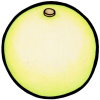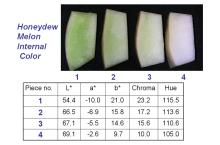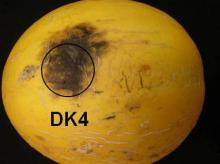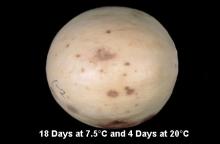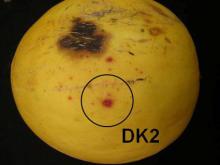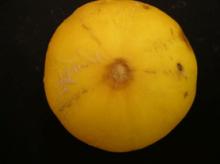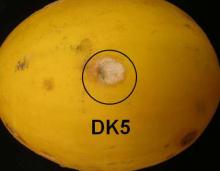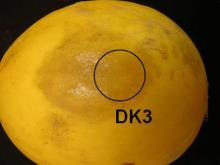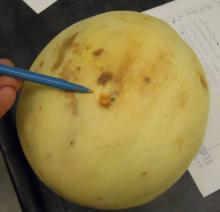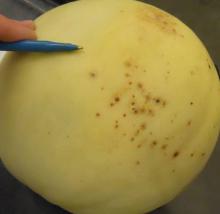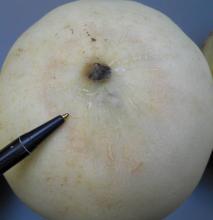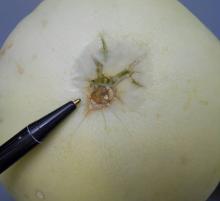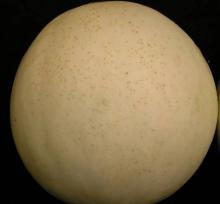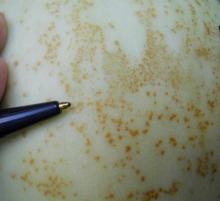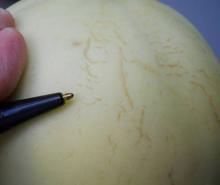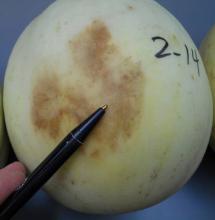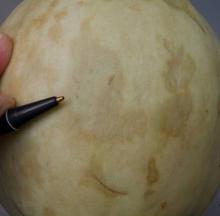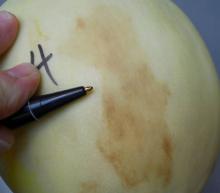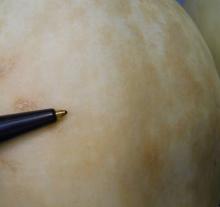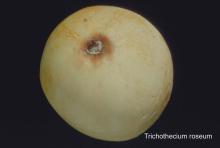Maturity and Quality
Honeydews are harvested by maturity and not by size. Maturity is difficult to judge because no clear abscission (slip, separation) from the vine occurs. Maturity classes are grouped predominantly by changes in 'ground color' from greenish to cream with yellow accents.
Commercial Maturity Classes:
- Mature, Unripe: Ground color white with greenish accents, no characteristic aroma, peel fuzzy/hairy and not waxy. California Grade Standards establish a minimum legal harvest index of 10% soluble solids (10° Brix).
- Mature, Ripening: Ground color white with slightly discernible green tint, slightly waxy peel, blossom-end firm and unyielding, no or slight aroma. Preferred commercial maturity class.
- Ripe Ground color creamy white with yellow accents, clearly waxy peel, characteristic aroma noticeable, blossom-end yields slightly to press.
- Well-shaped nearly spherical and uniform in appearance
- Absence of scars or surface defects, no evidence of bruising
- Appears heavy for size, surface waxy and not fuzzy
U.S. grades are No. 1, Commercial and No. 2. Distinction among grades is based predominantly on external appearances. Sizing is based on count per 13.6 kg (30 lb.) container, most typically 4 or 5, and occasionally 6 melons per carton. High quality appearance is protected, in part, by packing with a partition to protect melons from bruising, compression and scuffing.
Postharvest Handling and Storage
7-10°C (45-50°F) Storage life is typically 12-15 days at 7°C (45°F) with up to 21 days attainable.
Source authorities vary in the reported optimum storage and shipping temperatures for honeydew melons. Most recommendations use 7°C (45°F) and 85-90% R.H. as the optimum handling conditions. In general, if melons are ripe or pretreated with ethylene at 100 ppm for 24 hr, trade recommendations for short-term storage and shipping are often range from 2.5-5°C (36.5-41°F). Extended holding at these temperatures will induce chilling injury, rapidly evident after transfer to typical retail display temperature.
| Temperature | 0°C (32°F) |
5°C (41°F) |
10°C (50°F) |
15°C (59°F) |
20°C (68°F) |
25°C (77°F) |
|---|---|---|---|---|---|---|
| ml CO2/kg·hr | NR | 3-5 | 7-9 | 12-16 | 20-27 | 20-35 |
To calculate heat production multiply ml CO2/kg·hr by 440 to get Btu/ton/ day or by 122 to get kcal/metric ton/day.
NRNot recommended due to chilling injury.
Exposure to 100-150 ppm ethylene for 18-24 hr at 20°C (68°F) has been used to ripen physiologically mature honeydew melons. Immature fruit will not soften and develop characteristic sensory quality even with C2H4 treatment. Ripening with C2H4 is no longer a common practice for the California honeydew industry.
85-90%. High relative humidity is essential to prevent desiccation and loss of glossiness. Extended periods of higher humidity or condensation may encourage the growth of surface molds.
| Maturity | Class | µl /kg·hr at 20°C (68°F) |
|---|---|---|
| Intact fruit | 1 | 0.5-1.0 |
| 2 | 1.0-7.5 | |
| 3 | 7.5-10 | |
| Fresh-cut | 2 | 14-17 at 5°C (41°F) |
| 3 | 21-25 at 5°C (41°F) |
Controlled atmosphere storage or shipping offer only moderate benefits for honeydew melons under most conditions. With extended transit times (1-28 days), naturally ripening melons are reported to benefit from delayed ripening, reduced respiration and inhibition of molds and decay. Consensus conditions of 3% O2 and 10% CO2 at 7°C have been demonstrated. Elevated CO2 at 10-20% is tolerated but will cause effervescence in the fruit flesh. This carbonated flavor is lost on transfer to air.
Low O2 (<1%) or high CO2 (>20%) will cause impaired ripening, off-flavors and odors, and other defects.
Disorders
Chilling injury. Typically occurs after storage at temperatures <7°C (45°F) for several days. Sensitivity to chilling injury decreases as melon maturity and ripeness increases. Symptoms of chilling injury include pitting, reddish-tan discoloration's, failure to ripen, off-flavors and increased surface decay.
Disease is generally not an important source of postharvest loss in comparison with physical injury due to bruising and chilling injury. Commonly, decay or surface molds are caused by the fungal pathogens Cladosporium, Geotrichum, Rhizopus, Alternaria, and occasionally Mucor and Fusarium.
Special Considerations
Rapid forced-air cooling soon after harvest is strongly recommended, particularly if harvest pulp temperatures exceed 27°C (80°F). The precooling endpoint will depend on the desired intransit ripening, transit time, and trailer refrigeration capacities.
Fresh-cut honeydew melons rapidly absorb odors.
The optimum temperature and handling conditions for honeydew melons are essentially applicable to crenshaw and Persian melons. The anticipated keeping period, however, is shorter and generally does not exceed 14 days. Casaba, Juan Canary, and Santa Claus melons retain best quality at the high end of the storage temperature range, 10°C (50°F), for up to 21 days.
[For more information, see our publication “Fruit Ripening and Ethylene Management”, available for purchase using our Publication order form.]



